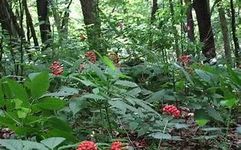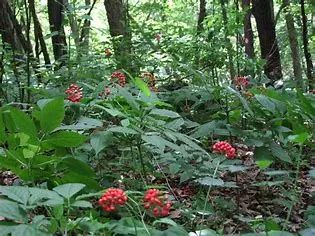
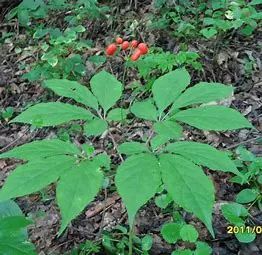
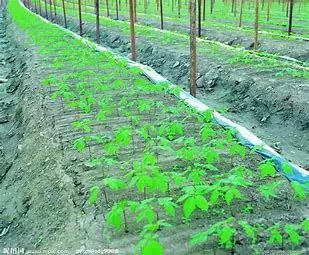
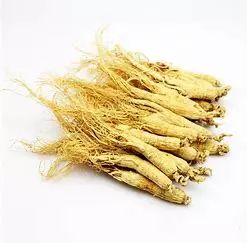
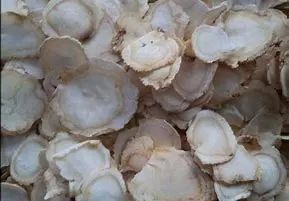
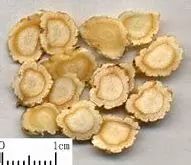
Compilation of National Chinese Medicinal Herbs: Ginseng
Pinyin Rén Shēn
Alias Bangchui, Shanshen, Yuanshen, Shenye
Source The root of the plant Panax ginseng C. A. Mey. (P. schin-seng Nees) from the family Araliaceae, with its leaves also used medicinally, referred to as Shenye. It is generally harvested from plants that are over five years old. Harvesting occurs in autumn, especially for wild ginseng, when the fruit matures and turns bright red, making it easier to find. When digging, it is best to include the fibrous roots, clean off the soil, and sun-dry it, known as “Shengshai Shen”. The product that is blanched in water, soaked in sugar, and then dried is called “Baitang Shen”. The product that is steamed and then dried is referred to as “Hongshen”.
Original Morphology A perennial herb, 30-60 cm tall. The main root is thick, fleshy, yellowish-white, cylindrical or spindle-shaped, with slight branching at the bottom; the rhizome (bulb) is short and upright. The stem is erect, cylindrical, and unbranched; a one-year-old plant has only one leaf, which has three leaflets, commonly known as “San Hua”; a two-year-old plant still has one leaf but has five leaflets, called “Bazhang”; a three-year-old plant has two opposite compound leaves with five leaflets, called “Er Jiazi”; a four-year-old plant has three whorled compound leaves, called “Dengtaizi”; a five-year-old plant has four whorled compound leaves, called “Sijia Ye”; a six-year-old plant has five whorled compound leaves, called “Wujia Ye”; the compound leaves are palmate, with 3-5 leaflets, the middle three being nearly equal in size, with small petioles; the leaflets are oval or slightly obovate, 4-15 cm long, 2-6.5 cm wide, tapering to a point, wedge-shaped at the base, with finely serrated edges, sparsely covered with fine hairs on the upper surface, and hairless on the underside, with the lowest pair of leaflets being very small and without petioles. Flowers bloom in summer, with a single umbel flower cluster at the top of the leaf cluster, with a total flower stalk length of up to 30 cm, each flower cluster having 4-40 flowers, with small flower stalks about 5 mm long. The bracts are small and lanceolate; the calyx is bell-shaped, fused with the ovary, with five lobes, green; the petals are five, ovate, entire, pale yellow-green; there are five stamens with short filaments; one pistil, with a lower ovary, two chambers, and two styles, the upper parts separate and the lower parts fused. The fruit is a flattened round berry, bright red when mature, containing two semi-circular seeds.
Wild ginseng is referred to as “Yeshan Shen”, while cultivated ginseng is called “Yuanshen”. The differences in medicinal materials between the two are as follows:
Wild Ginseng has a rhizome with dense bulbous growths on the upper part, and longer round bulbs on the lower part. The upper end of the main root has fine, deep spiral grooves. The middle and lower parts generally have no grooves. The fibrous roots are sparse and long, not easily broken. They have obvious wart-like protrusions.
Cultivated Ginseng has a rhizome with bulbous growths on one or both sides, without round bulbs. The upper end of the main root has coarse transverse grooves, not spiral, and sometimes the entire root shows transverse grooves. The fibrous roots are broom-like, shorter and brittle, with less obvious wart-like protrusions.
Habitat Distribution Grows in dense forests on mountain slopes, distributed in the northeastern provinces of China. Large-scale cultivation occurs in Liaoning and Jilin, with recent cultivation also in Hebei, Shanxi, Shaanxi, Gansu, Ningxia, and Hubei.
Cultivation Prefers cool, moist climates and is cold-resistant. It thrives in oblique and diffuse light, avoiding strong light and high temperatures. It has strict soil requirements, suitable for well-drained, humus-rich sandy loam and loam. Seed propagation can be done in summer, autumn, or spring. Summer sowing occurs in July-August when the fruit is ripe, immediately after harvesting. Autumn sowing is done in November, and spring sowing in early to mid-April. Before sowing, the land is prepared into beds 0.7-1 foot high and 3.8-4 feet wide, with working paths between beds of 6-8 feet. Broadcasting is used, with 1 tael per square meter, covered with 1-1.5 inches of soil, and the soil kept moist until seedlings emerge around early May. For autumn and spring sowing, artificial germination is necessary. The germination method involves digging a pit 5-6 inches deep, the size depending on the amount of seeds, mixing sand with seeds in a 1:1 ratio, placing them in the pit, covering with 2-3 inches of soil, and keeping the soil moist. After about two months, when cracks appear, sowing can occur. In the third year, transplanting is done with a row and plant spacing of 6×3 inches, covered with 1.5-2 inches of soil. Before seedlings emerge, a shade structure with a front eave height of 3-4 feet and a back eave height of 2-3 feet should be built. During growth, diseases such as leaf spot, blight, and anthracnose can occur, which can be controlled with Bordeaux mixture sprays.
Chemical Composition The root contains 0.4% ginsenosides and a small amount of volatile oil. The main component of the oil is panaxene (C15H24) at 0.072%. Reports indicate that ginsenosides A, B, C, D, E, and F (panaxoside A, B, C, D, E, F) have been isolated from the root. Ginsenoside A (C42H72O14) is ginsenoside Rg1. Ginsenosides B and C yield panaxatriol aglycone upon hydrolysis, while ginsenosides D, E, and F yield 20-epiproto panaxadiol aglycone. Additionally, β-elemene (C15H24) has been isolated from the low-boiling point fraction of the ether extract. The high-boiling point fraction yielded panaxynol (C17H26O). It also contains monosaccharides: glucose, fructose, sucrose, and three trisaccharides: glucose-fructose-fructose, maltotriose, glucose-glucose-fructose, as well as ginsenoside acids (a mixture of stearic acid, palmitic acid, and linoleic acid), multiple vitamins (B1, B2, niacin, niacinamide, pantothenic acid), various amino acids, choline, enzymes (maltase, invertase, esterase), spermine, and cholamine. The aerial parts of ginseng contain flavonoids, known as panaxenoside, trifolin, ginsenoside, β-sitosterol, and sugars.
Pharmacological Effects 1. Ginseng has a stimulating effect on the central nervous system, but in large doses, it can have an inhibitory effect. It enhances the excitatory and inhibitory processes of higher nervous activity in animals and increases the body’s adaptability to all non-specific stimuli, reducing fatigue (the roots, stems, and leaves of ginseng can prolong the swimming duration of mice).
2. Ginseng has a direct effect on the myocardium and blood vessels, generally stimulating at low doses and inhibiting at high doses. A 10% ginseng infusion at 1 ml/kg administered to cats (or rabbits) can improve myocardial weakness to a certain extent. During rewarming, there is a considerable degree of recovery. It also has anti-allergic shock and cardiotonic effects. Ginseng inhibits the activity of ATPase in rat myocardial cell membranes.
3. It enhances the body’s resistance to harmful factors: (1) It can prevent acute death in chickens infected with malaria parasites, and the chickens gradually gain weight. (2) It can inhibit the febrile response in experimental animals caused by the injection of milk or vaccines. (3) It can enhance the human body’s ability to adapt to temperature changes. (4) In dogs that have lost a large amount of blood or are in a state of asphyxia, immediate injection of ginseng preparations can stabilize blood pressure that has dropped to very low levels. (5) It can prolong the survival time of mice infected with trypanosomiasis. (6) It can inhibit the systemic inflammatory response caused by the injection of turpentine or frostbite in rabbit ears. (7) It promotes the healing of certain experimental injuries. (8) It has anti-deficiency effects for vitamin B1 and B2. (9) It can accelerate the healing of experimental corneal ulcers in rabbits. (10) It can reduce the effects of certain toxins (benzene, tetraethyl lead, triethyl phosphate) on the body.
4. It lowers blood sugar in animals with hyperglycemia induced by adrenaline; in diabetic patients, it not only improves symptoms but also has a slight hypoglycemic effect and works synergistically with insulin.
5. It promotes the function of the gonads in animals; mice fed small amounts of ginseng exhibit a tail-raising phenomenon.
6. At appropriate doses, it can also increase the weight of rabbits, raising the ratio of plasma albumin to globulin.
7. It stimulates hematopoietic organs and has an effect on improving anemia.
8. Long-term use of small amounts can enhance the reticuloendothelial system; excessive doses can have the opposite effect.
Taste and Properties Sweet, slightly bitter, slightly warm.
Main Functions and Indications Tonifies Qi, stabilizes collapse, generates fluids, calms the spirit, benefits intelligence. Used for shortness of breath, palpitations, forgetfulness, excessive thirst, profuse sweating, poor appetite, weakness, and all acute and chronic diseases, as well as shock and collapse caused by blood loss.
Dosage 0.5-3 qian, large doses can be up to 1 liang.
Precautions Should not be used with Li Lu or Wu Ling Zhi.
Formulas 1. For collapse due to major blood loss or any acute or chronic disease, with pale complexion, profuse sweating, cold limbs, and weak breathing: (Du Shen Tang) Ginseng 0.5-1 liang, decoct in water for oral administration; or (Shen Fu Tang) add prepared Aconite 2-4 qian, decoct for over 1 hour for oral administration.
2. For Qi and Yin deficiency, with excessive thirst and shortness of breath: (Sheng Mai San) Ginseng 1 qian, Mai Dong 3 qian, Wu Wei Zi 1 qian, decoct for oral administration.
Excerpt Compilation of National Chinese Medicinal Herbs
Dictionary of Chinese Medicine: Ginseng
Pinyin Rén Shēn
Alias Renxian, Guigai (“Shennong’s Classic”), Tujing, Shencao, Huangshen, Xueshen (“Wupu Bencao”), Dijing (“Guangya”), Baichi Chuo (“Bencao Tujing”), Haiyu, Jinjing Yulan, Hairen Shen (“Gangmu”), Bangchui (“Liaoning Major Medicinal Materials”).
Source “Shennong’s Classic”
Source The root of the plant Panax ginseng.
1. Cultivated Ginseng
Harvest ginseng that has grown for over 6 years between September and October. Carefully dig it up with a pickaxe to prevent breaking or injuring the roots, remove the soil, and process it. Fresh products are called “Yuanshen Shuizi”. Freshly harvested mountain ginseng is called “Yishan Shen Shuizi”.
2. Wild Ginseng
Harvest between May and September. Use a bone needle to loosen the soil, carefully pull out the roots and fibrous roots to prevent breaking, clean off the soil and leaves. Fresh products are called “Yeshan Shen Shuizi”.
Original Morphology A perennial herb, up to 60 cm tall. The main root is large, fleshy, cylindrical, often branched, with the upper part of the root bifurcating referred to as “Lingti” or “Hengti”; those that are not bifurcated or bifurcate at the lower part are referred to as “Benti” or “Guti”; fibrous roots are long with many small wart-like protrusions; the rhizome has stem scars, sometimes producing adventitious roots. The stem is erect, green, slender, cylindrical, smooth, and hairless. Leaves whorled at the top of the stem, varying in number depending on age: initially one 3-foliate compound leaf, two-year-olds have one 5-foliate palmate compound leaf, three-year-olds have two 5-foliate palmate compound leaves, four-year-olds have three leaves, increasing yearly to a maximum of six; leaves have long petioles; leaflets are oval or obovate, with the lower leaflets smaller, 2-3 cm long and 1-1.5 cm wide; upper leaflets are 4-15 cm long and 2.2-4 cm wide; tapering to a point, wedge-shaped at the base, extending downwards, with finely serrated edges, with upright fine hairs along the leaf veins on the upper surface, and hairless on the underside; the petioles can be up to 2.6 cm long. The total flower stalk emerges from the center of the leaf petiole, about 7-20 cm long, with a terminal umbel flower cluster containing dozens of pale yellow-green small flowers, usually starting to bloom in the fourth year; flowers have stalks, are bisexual and male; the calyx is green, with 6 lobes; petals are 6, pointed at the tip; there are 5 stamens; the ovary is inferior, with 2 chambers, and 2 styles, separate in bisexual flowers and fused in male flowers forming a hollow tube. The fruit is a drupe, kidney-shaped, bright red when mature, with one seed per chamber.
Ginseng is found in dense forests. It is distributed in the deep mountains of Heilongjiang, Jilin, Liaoning, and northern Hebei. Large-scale cultivation occurs in Liaoning and Jilin. Wild ginseng is referred to as “Yeshan Shen”; cultivated ginseng is called “Yuanshen”. If young wild ginseng is transplanted to fields, or young cultivated ginseng is transplanted to mountains and grows, it is called “Yishan Shen”.
The roots (ginseng bulb), adventitious roots (ginseng strips), fibrous roots (ginseng whiskers), leaves (ginseng leaves), flowers (ginseng flowers), and fruits (ginseng seeds) are also used medicinally, each detailed in specific entries.
Processing Methods The processing methods for ginseng are mainly divided into four categories: red ginseng, sugar ginseng, sun-dried ginseng, and others:
1. Red Ginseng
Take cultivated ginseng, remove the fibrous roots, wash thoroughly, steam for 2-3 hours until the ginseng root turns yellow and the skin becomes semi-transparent, then dry it. Main products include red ginseng and edge strips.
2. Sugar Ginseng
Take fresh ginseng, wash thoroughly, soak in boiling water for 3-7 minutes, remove, then soak in cold water for about 10 minutes, take out and dry, then sulfur fumigate. Use a special needle to make small holes along the ginseng body in parallel and perpendicular directions, soak in concentrated sugar juice (135 grams of sugar in 100 ml of water) for 24 hours. After taking it out, dry it for one day, then use a damp towel to moisten it, soften it, make a second set of holes, and soak in concentrated sugar juice for 24 hours. After taking it out, wash off excess sugar and dry or bake it. Main products include white ginseng (processed from cultivated or transplanted mountain ginseng) and sugar ginseng (processed from various fresh ginseng).
3. Sun-Dried Ginseng
Take fresh ginseng, wash thoroughly, sun-dry for one day, then sulfur fumigate and dry. Main products include sun-dried ginseng, whole whisker sun-dried ginseng, and white dry ginseng.
4. Other Types
(1) Skin-peeled ginseng: The processing method is similar to sugar ginseng, generally soaking the ginseng body in boiling water three times, each time for 1-2 minutes, until about three parts cooked, then soaking the fibrous roots in boiling water for about 20 minutes. After making holes in the ginseng body, place it in a thinner sugar juice for three soaks, then dry it over low heat to separate the skin from the inner part, and lightly prick the outer skin to form dots. (2) Strong ginseng: Take fresh ginseng, briefly boil in boiling water, then dry.
Ginseng products are prone to moisture and sugar return, so they should be stored in a dry, cool place, sealed, and protected from insects.
Characteristics 1. Cultivated Ginseng
Also known as seedling ginseng. The main root (ginseng body) is cylindrical, light yellow on the surface, with intermittent transverse grooves on the upper part. The rhizome (bulb) is about 2-6 cm long, with a diameter of about 0.5-1.6 cm, with sparse bulbous stem scars (bulb) and one to several adventitious roots (ginseng whiskers). There are 2-6 fibrous roots, often branched, with many long whisker-like roots, with small wart-like protrusions (pearl dots).
Due to different processing methods, cultivated ginseng products mainly include the following: (1) Red Ginseng: The main root is about 5-20 cm long, with a diameter of about 0.7-2 cm. The surface is reddish-brown, semi-transparent, with large longitudinal wrinkles, and the transverse grooves are not obvious, with fibrous root marks. The rhizome is yellowish-brown, with 4-6 bulbous stem scars. It is hard and brittle, with a flat cross-section, horn-like, reddish-brown, with a light-colored center. It has a fragrant aroma and a slightly bitter taste. (2) Edge Strip Ginseng: Similar characteristics to red ginseng, but generally has a longer rhizome, cylindrical body, and longer fibrous roots. (3) Sugar Ginseng: The main root is about 3.5-12 cm long, with a diameter of 0.6-2 cm. The surface is light yellow-white, with more intermittent transverse grooves at the top, with peeling and fine root marks all over. The cross-section is flat, powdery, yellow-white, sometimes with a light yellow ring near the phloem, and the center often has radial cracks. It has a fragrant aroma and a sweet, slightly bitter taste. (4) White Ginseng: Similar characteristics to sugar ginseng, with a better shape, resembling wild ginseng, but generally straighter, with a longer rhizome than red ginseng, and fibrous roots dispersed, short and brittle. (5) Sun-Dried Ginseng: The main root is about 3-10 cm long, with a diameter of about 0.3-2 cm. The surface is earth-yellow, with black-brown transverse grooves and longitudinal wrinkles, with fine fibrous roots and whiskers removed, leaving only traces. It is brittle, light, with a flat white cross-section, and radial cracks. It has a fragrant aroma and a bitter taste. Those with complete rhizomes and fibrous roots are called “whole whisker sun-dried ginseng”. (6) White Dry Ginseng: The main root has had its skin completely removed, with a surface that is light yellow or whitish, with indistinct transverse grooves at the top, but visible shallow longitudinal wrinkles and fibrous root marks. Other characteristics are similar to sun-dried ginseng. (7) Skin-Peeled Ginseng: The main root is about 6-15 cm long, with a diameter of about 1.2-2.5 cm, with a surface that is light yellow, with indistinct transverse grooves at the top, but many processing-induced depressions. The fibrous roots are light brown, tied together with the whiskers into a cow-tail shape. The cross-section is white. It has a fragrant aroma and a sweet, slightly bitter taste. (8) Strong Ginseng: The main root is 5-15 cm long, with a surface that is light yellow, semi-transparent, with obvious longitudinal wrinkles, and brown transverse grooves at the top. The fine fibrous roots and whiskers are removed. It is hard and brittle, with a flat, transparent, horn-like cross-section. It has a fragrant aroma and a bitter taste.
For cultivated ginseng products, those with longer bodies, thicker fibrous roots, and longer rhizomes are preferred. Thin, small fibrous roots and short rhizomes with heavy sugar content are of lower quality.
Mainly produced in Jilin, followed by Liaoning, Yanbian Korean Autonomous Prefecture, and other areas.
2. Wild Ginseng
Also known as mountain ginseng. The main root is short, equal to or shorter than the rhizome, often with two main fibrous roots, resembling the human body. The upper end has fine, deep transverse grooves. The rhizome is slender, generally 3-9 cm long, twisted at the top, commonly referred to as “Goose Neck Bulb”, with dense bulbous growths at the top, and smooth at the bottom, commonly called “Round Bulb”. The fibrous roots are sparse, about 1-2 times the length of the main root, flexible and not easily broken, with obvious wart-like protrusions (pearl dots). The entire plant is light yellow-white, with fine, smooth skin. It has a strong aroma and a sweet, slightly bitter taste.
Due to different processing methods, wild ginseng products include sun-dried ginseng, sugar ginseng, and skin-peeled ginseng. Their characteristics, except for the whole shape, are similar to corresponding cultivated ginseng products: those with large fibrous roots, sufficient sap, fine grooves, long rhizomes, dense bulbous growths, and pearl dots are preferred.
Mainly produced in Jilin, Liaoning, Heilongjiang, and other areas.
3. Transplanted Mountain Ginseng
Resembles wild ginseng, but the lower part of the main root is often thicker, with coarse and shallow grooves, often extending to the middle of the main root, with fewer pearl dots on the fibrous roots. Processed products are the same as wild ginseng.
4. Korean Ginseng
Ginseng produced in Korea, commonly referred to as Korean ginseng, also known as Biezhi Shen or Goryeo Ginseng. Products include Korean red ginseng and Korean white ginseng, with red being superior.
(1) Korean Red Ginseng
The processing method is the same as that for domestic red ginseng. It is sturdier, with double hoof bulbs at the shoulders, and single bulbs are called “Duwan Bulb”, with deep indentations in the middle and very neat edges, and a hard texture. The main root is about 6-10 cm long, with a diameter of about 1-2 cm. The surface is reddish-brown, with longitudinal grooves, and the upper part may show yellow skin, with obvious longitudinal ridges. The fibrous roots are often curved and crossed. It has a hard texture and is heavy. The cross-section is horn-like and shiny, with chrysanthemum patterns. It has a strong aroma and a sweet, slightly bitter taste.
(2) Korean White Ginseng
The bulbous growths resemble cultivated ginseng, with a cylindrical shape. The surface is yellow-white, with shallow brown fine lines. Most fibrous roots are removed, with a loose texture. The cross-section has a round center. It has a slight aroma and a sweet, slightly sour taste.
Additionally, ginseng cultivated in Japan is commonly referred to as Oriental ginseng, first recorded in “Gangmu Shiyi”, and products are divided into white and red ginseng based on processing.
Processing Sugar ginseng: Remove the bulbous growths and cut into sections. Red ginseng: Remove the bulbous growths and cut into sections, or wrap in a damp cloth, soften, and slice, then dry.
Taste and Properties Sweet, slightly bitter, warm.
1. “Shennong’s Classic”: “Taste is sweet, slightly cold.”
2. “Bielu”: “Slightly warm, non-toxic.”
3. “Bencao Beiyao”: “Raw, sweet and bitter, slightly cool; cooked, sweet, warm.”
Meridian Entry Enters the spleen, lung, and kidney meridians.
1. “Bencao Yanyi Buzhi”: “Enters the hand Taiyin.”
2. “Bencao Huiyan”: “Enters the lung and spleen meridians.”
3. “Yaopin Huayi”: “Enters the spleen, stomach, and lung meridians.”
Main Functions and Indications Greatly tonifies original Qi, stabilizes collapse, generates fluids, calms the spirit. Used for labor injury, food deficiency, fatigue, vomiting, diarrhea, shortness of breath, spontaneous sweating, palpitations, forgetfulness, dizziness, headache, impotence, frequent urination, diabetes, women’s metrorrhagia, children’s chronic fright, and all conditions of Qi, blood, and fluid deficiency.
1. “Shennong’s Classic”: “Mainly tonifies the five organs, calms the spirit, stops palpitations, eliminates evil Qi, brightens the eyes, and benefits intelligence.”
2. “Bielu”: “Treats cold in the stomach and intestines, abdominal pain, chest fullness, cholera, vomiting, regulates the middle, stops thirst, opens blood vessels, breaks up accumulations, and prevents forgetfulness.”
3. “Yaoxing Lun”: “Mainly for Qi deficiency of the five organs, labor injuries, weakness, vomiting, and inability to retain food, stops cholera, relieves anxiety and vomiting, tonifies the five organs and six bowels, protects the center and guards the spirit.”
4. “Rihua Zibencao”: “Regulates the middle, treats Qi, digests food, and opens the appetite.”
5. “Zhenzhu Nang”: “Nourishes blood, tonifies stomach Qi, and drains heart fire.”
6. “Yixue Qiyuan”: “Treats deficiency of spleen and stomach Yang Qi and lung Qi, shortness of breath, and less Qi, tonifies the middle and alleviates, drains lung, spleen, and stomach fire evil.”
7. “Dianan Bencao”: “Treats deficiency of Yin and Yang, weak lung Qi.”
8. “Bencao Mengquan”: “Stops cough, opens blood vessels, drains Yin fire, and nourishes original Yang.”
9. “Gangmu”: “Treats all deficiency syndromes in men and women, fever, spontaneous sweating, dizziness, headache, vomiting, malaria, diarrhea, frequent urination, hematuria, blood stasis, bleeding, and various diseases before and after childbirth.”
Dosage For internal use: decoction, 0.5-3 qian, large doses 0.3-1 liang; can also be made into a paste or used in pills or powders.
Precautions Avoid use in cases of excess conditions or heat syndromes.
1. “Bencao Jing Jizhu”: “Fu Ling is a guide. Avoid urination. Opposes Li Lu.”
2. “Yaodui”: “Avoid Wu Ling Zhi. Opposes soapberry and black beans. Avoid purple quartz.”
3. “Yaoxing Lun”: “Ma Lin is a guide. Avoid salty foods.”
4. “Yixue Rumen”: “Use cautiously in cases of Yin deficiency with fire cough and hemoptysis.”
5. “Yuechi Ren Shen Zhuan”: “Avoid iron utensils.”
6. “Yaopin Huayi”: “If there is heat in the spleen and stomach, lung fire evil, cough with phlegm, initial blood loss, chest tightness, constipation, or worms, do not use.”
Formulas 1. For deficiency of Ying and Wei Qi, weak organs, abdominal fullness, no appetite, bowel sounds, diarrhea, vomiting: Ginseng (remove bulb), Bai Zhu, Fu Ling (remove skin), Gan Cao (roasted), equal parts. Grind into fine powder, take 2 qian each time, with one cup of water, decoct to 7 parts, take orally, not restricted by time, add a little salt, or drink with white soup. Regular use warms the spleen and stomach, increases appetite, and dispels cold evil and miasma. (“Jufang” Si Junzi Tang)
2. For cold in the stomach, Qi fullness, inability to digest, and good hunger but unable to eat: Ginseng powder 2 qian, raw Aconite powder 0.5 qian, fresh ginger 1 fen (chopped). Mix these three ingredients, use 7 parts of water, decoct to 2 parts, take one egg, beat it, and take it on an empty stomach. (“Shengji Zonglu” Weng Wei Zhu San)
3. For chronic cough due to lung deficiency: Ginseng powder 2 liang, deer antler glue (roasted, ground) 1 liang. Each dose is 3 qian, use mint and soy soup, add a little green onion, boil once or twice, pour into a cup, and take warm when coughing. (“Shiliao Bencao”)
4. For lung Qi cough with phlegm and blood, facial sores, and generalized swelling: One pair of geckos (whole, soaked in river water for five nights, changing water daily, wash off the fishy smell, and roast until yellow), apricot kernels (peeled and roasted), and licorice (roasted), each 5 liang, along with Zhimu, mulberry bark, ginseng, and Fu Ling (remove skin), and fritillary bulb, each 2 liang. Grind these eight ingredients into powder, store in a clean container. Take as tea. (“Weisheng Baojian” Ginseng Gecko Powder)
5. For Yang deficiency, shortness of breath, spontaneous sweating, and night sweats: Ginseng 5 qian, cooked Aconite 1 liang. Divide into four doses, each dose with 10 slices of fresh ginger, 2 cups of water, decoct to 1 cup, take warm on an empty stomach. (“Jisheng Fang”)
6. For deficiency of heart Qi, palpitations, and spontaneous sweating: One pig kidney, boiled in two bowls of water until reduced to one and a half bowls, cut the kidney into small pieces, add half a liang of ginseng, and half a liang of Angelica (remove bulb, use the middle section). Cut and decoct until 8 parts, eat the kidney, and take the juice. If there are leftovers, dry the two medicinal residues, grind into fine powder, and make pills the size of a wutong seed, taking 30-50 pills each time. (“Baiyi Xuanfang”)
7. For unstable heart Qi, insufficient organs, confusion, palpitations, forgetfulness, nightmares, and anxiety: Yuan Zhi (remove seedlings and heart) and Acorus each 2 liang, Ginseng and Bai Fu Ling (remove skin) each 3 liang. Grind into fine powder, make honey pills the size of a wutong seed, coat with vermilion. Take 7 pills, increasing to 20 pills, with warm rice drink after meals. (“Jufang” Ding Zhi Wan)
8. For diabetes with excessive thirst: Ginseng and Trichosanthes root in equal parts. Grind raw, make into honey pills the size of a wutong seed, taking 30 pills each time, with Mai Dong soup. (“Renzhai Zhizhi Fang” Yuhuwan)
9. For excessive thirst: Ginseng powder, take 1 qian with fresh chicken broth, three to four times a day. (“Gangmu”)
10. To replenish after bleeding: Large ginseng (remove bulb) 2 liang, five dates. Each dose with 2 cups of water, decoct to 1 cup. Take small sips, and after sleeping well, all diseases will be cured. (“Shiyao Shenshu” Du Shen Tang)
11. For hemoptysis and hematochezia due to emotional distress, alcohol, and internal injury, with Qi and blood flowing erratically, bleeding from mouth and nose, and heart and lung pulse scattering, with blood like a fountain: Ginseng (roasted), Platycladus leaves (steamed and roasted), and Schizonepeta spikes (burned to preserve) each 5 qian. Grind into powder, take 2 qian, mix with 2 qian of flour, and take with fresh water as a thin paste, repeat after a while. (“Zhongcang Jing”)
12. For children with fright and misalignment of pupils: Ginseng and Ejiao (glutinous rice roasted into pearls) each 1 qian. Use one cup of water, decoct to 7 parts. Take warm, twice a day, stopping when cured. (“Renzhai Zhizhi Fang”)
13. For dysentery with locked mouth: Ginseng and lotus meat each 3 qian. Use two cups of well water, decoct to one cup, take slowly, or add ginger juice and fry Huanglian 3 qian. (“Jingyan Liangfang”)
14. For chest obstruction and heart Qi fullness, with Qi stagnation in the chest, fullness, and counterflow under the ribs: Ginseng, licorice, dried ginger, and Bai Zhu each 3 liang. Combine these four ingredients with 8 liters of water, boil to obtain 3 liters, take 1 liter warm, three times a day. (“Jinkui Yaolue” Ginseng Decoction)
15. For cholera with agitation: 2 fen of cinnamon heart (powder), half a liang of ginseng (remove bulb). Combine with one large cup of water, decoct to 7 parts, remove residue, divide into two warm doses. (“Shenghui Fang”)
16. For febrile malaria: 2 qian and 2 fen of ginseng, 5 qian of realgar. Grind into powder, make into pills the size of a wutong seed. On the day of onset, take 7 pills with well water in the morning, and take again before the onset. Avoid all hot foods. (“Danmo Zuanyao”)
17. For nausea and vomiting during pregnancy, with abdominal pain and inability to eat: Ginseng (remove bulb) and dried ginger (roasted) in equal parts. Grind into powder, make into pills the size of a wutong seed, taking 50 pills with rice soup before meals. (“Jufang” Xiao Dihuang Wan)
Clinical Applications 1. For emergency rescue
Large doses of ginseng (0.3-1 liang) can be decocted or stewed, or ginseng injection (each ml contains 0.57 g of raw medicine) 2-4 ml can be administered intramuscularly or intravenously for emergency treatment of cardiogenic shock or other critically ill patients; ginseng combined with Aconite can save those with Yang deficiency collapse.
2. Treatment of cardiovascular diseases
Ginseng has certain therapeutic effects on hypertension, myocardial dystrophy, coronary artery sclerosis, and angina pectoris, which can alleviate various symptoms. Ginseng has a regulatory effect on abnormal blood pressure, with different doses producing different effects: low doses can raise blood pressure, while high doses can lower it. The common daily dosage for adults is 0.2-3 qian; ginseng extract (each ml equals 1 g of raw medicine), 20-40 drops each time, taken 2-3 times a day; ginseng tincture (10% concentration), 5 ml each time, taken 2-3 times a day; ginseng powder, 3-6 fen each time, taken 2-3 times a day.
3. For stomach and liver diseases
For chronic gastritis with insufficient gastric acid or low acidity, taking ginseng can increase appetite and alleviate or eliminate symptoms, but it does not significantly affect gastric juice secretion or acidity. Reports also indicate that ginseng can relieve stomach pain in chronic gastritis patients, enhance appetite, normalize bowel movements, and increase total acidity of gastric juice. For acute infectious hepatitis, under certain treatment conditions, taking ginseng seems to have a positive significance in preventing the transition to chronic hepatitis.
4. Treatment of diabetes
Ginseng can improve the general condition of diabetic patients, but does not change the degree of hyperglycemia. It is said that ginseng can reduce urine sugar in mild diabetes patients and lower blood sugar by 40-50 mg%, maintaining this effect for over two weeks after stopping medication; in moderate diabetes patients, although the hypoglycemic effect is not obvious, most show improvement in overall condition, such as reduced thirst and other symptoms; some patients may reduce their insulin dosage after taking ginseng.
5. For mental illness
Ginseng seems to have therapeutic effects on asthenic and asthenic-depressive types of mental illness, regardless of the cause (schizophrenia, poisoning, or infectious disease-induced mental illness, degenerative mental illness, etc.). It is also believed that oral ginseng can only improve the general subjective symptoms of patients with organic neurological diseases, without significant objective therapeutic effects.
6. Treatment of neurasthenia
Ginseng has a significant stimulating effect on the nervous system, enhancing physical activity and reducing fatigue; it has a certain therapeutic effect on different types of neurasthenia patients, leading to weight gain and alleviating or reducing symptoms such as general weakness, headache, and insomnia.
7. Treatment of impotence
In traditional Chinese medicine, ginseng is generally used as a tonic to nourish original Qi; recent studies have proven its effect in enhancing gonadal function. Ginseng tincture has significant efficacy for impotence of the paralysis type and premature ejaculation, but is ineffective for the psychological type; it also has certain therapeutic effects for impotence caused by neurasthenia.
8. Others
Ginseng also has the effect of improving vision and enhancing visual dark adaptation. When combined with other medications, it can treat various diseases. However, in clinical practice, it is contraindicated for excess conditions, such as asthma caused by sudden Qi stagnation, throat dryness caused by heat, and hemoptysis or epistaxis caused by impulsive actions.
Excerpt Dictionary of Chinese Medicine
Chinese Materia Medica: Ginseng
Pinyin Rén Shēn
English Name Ginseng, Ginseng Root
Alias Renjie, Guigai, Huangshen, Yujing, Xueshen, Tujing, Dijing, Jinjing Yulan, Hairen Shen, Bangchui
Source Medicinal material source:
Latin botanical name: Panax ginseng C. A. Mey. (P. schin-seng Nees)
Meridian Entry Enters the lung; spleen heart; kidney meridians
Excerpt Chinese Materia Medica

